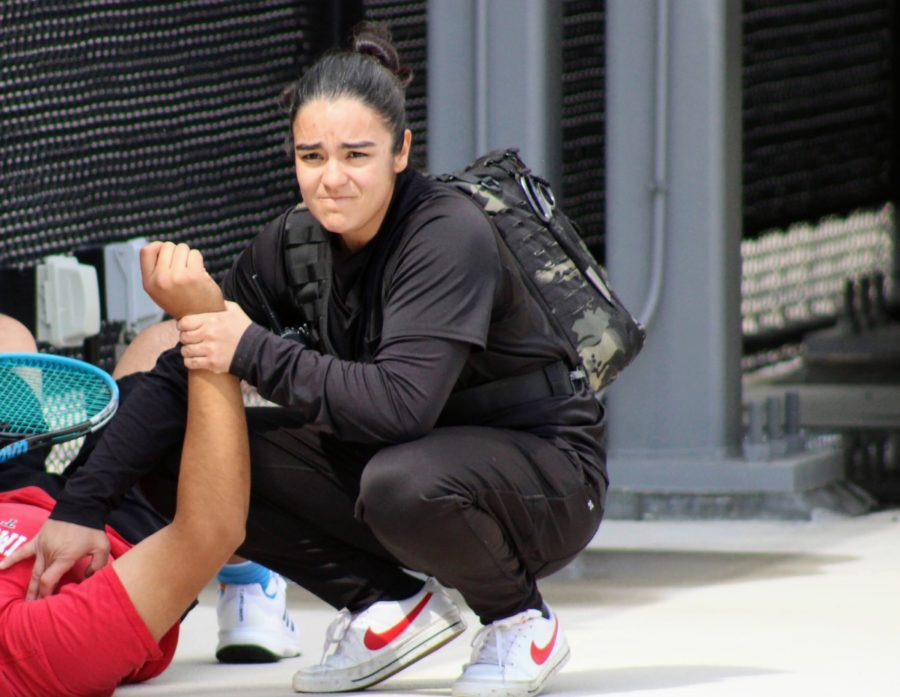The unsung heroes of the sports world: Athletic trainers
Acknowledge the work your athletic trainers do during National Athletic Training Month and beyond
Athletic Trainer Elva Salcido evaluating an athlete for a possible shoulder injury. To ensure player safety, athletic trainers will check on any injured athletes before they participate in games or practices.
Keyontae Johnson. Damar Hamlin. Kevin Ware. Paul George. Josh Cribbs. Willis McGahee. Derrick Rose. Akil Mitchell. What do all these individuals have in common aside from the obvious career-ending injuries they sustained?
The answer – an athletic trainer was the first on scene to provide immediate care to the athlete.
What if there was not an athletic trainer to come to their aid and attention? Would athletes feel safe? Would their performance be altered because no one is there to make sure that the athletes’ well-being is their first priority?
Some athletes, like former Mt. SAC linebacker Te’Vion Reed, 26, believes sports like football are inherently dangerous.
“There’s a lot of risk that comes when you step on that field but [injuries] never cross your mind,” Reed said. “I was locked in and prepared to face the consequences that came with the game. Even if there wasn’t a trainer on site, I’d still play.”
While there is a general injury risk in playing sports, an athletic trainer can prevent certain injuries from happening.
What is an athletic trainer? Aren’t they the same thing as a regular trainer or physical therapist?
The answer is no. In fact, athletic trainers are far from it.
Mt. SAC head athletic trainer Ali Lacayo, 37, lamented being confused, mistaken or assumed as a physical therapist.
“It bothered me a lot back then,” Lacayo said. “We are athletic trainers! But I’ve now learned to view it as an opportunity to educate people on what we do and the differences between the various professions. And as the years have gone by in my profession, I’ve seen more people who are knowledgeable of athletic trainers, or even referring to us as an athletic trainer versus the word trainer. We have been able to steer from that. So, it is getting better. But yes, at least it used to bug me.”
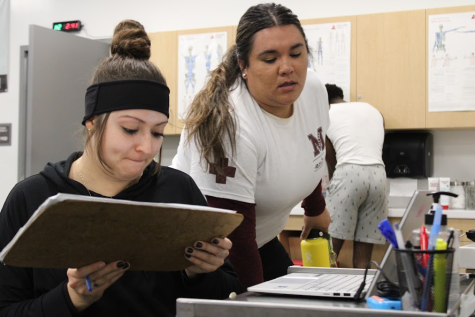
Most people think all athletic trainers do is tape up your ankles or give you a bag of ice. That is a stereotype. There is so much more to athletic trainers than you realize.
ATs oftentimes are the first responders to an injury on the court or field of play and improve the health and safety of the athletes. Injury prevention is a pivotal aspect in athletes’ safety. Not just at the professional level, but college, high school, Olympic, recreational, medical and military.
Lacayo believes this sentiment to be the primary reason why ATs are important, stating, “I’d say [injury prevention] is imperative. All of us have different biomechanical predispositions. We want to be able to have our athletes recognize what their body needs in regard to strengthening and coordination. Ideally, we do not want our athletes to be hurt out there. But if we can decrease that risk that would be optimal.”
But injury prevention goes beyond the scope of rehab exercises and strength conditioning.
“There’s also prevention in regard to hydration and recognizing external factors that may play a role,” she said. “An example is recognizing if there’s lightning outside and keeping the population safe or that the terrain is safe to play on. Or even just the temperature that the turf is going to create versus regular grass as well as proper hydration or giving enough breaks and making sure that the temperature is not too hot for them to be out there as important.”
“So, injury prevention can be observed in the capacity of environmental as well as the individual [athlete],” Lacayo continued.
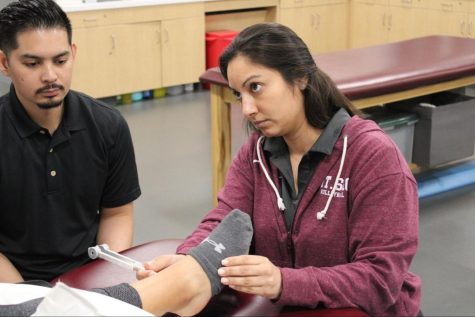
According to John Hopkins Medicine, there are about 30 million student athletes between the ages of 5-22. Every day, an average of 9,600 athletes sustain an injury while playing or practicing. Totaled for a full year, that number skyrockets to over 3.5 million injured athletes.
Furthermore, the statistics indicated that sports and recreational activities account for 21% of injuries sustained in the U.S.
John Hopkins Medicine’s sports injury page states that, “Although death from a sports injury is rare, the leading cause of death from a sports-related injury is a brain injury.” These injuries include concussions which result in chronic traumatic encephalopathy, more commonly known as CTE.
50% of these injuries occur in practice. Recurring brain injuries like this are preventable in sports like football, boxing, wrestling and martial arts with a certified athletic trainer on-site.
As far as the industry has come, there is still much progress to be made. One positive trend Lacayo noted that can be improved was the increasing need for athletic trainers.
“There has been a lot more recognition of athletic trainers and the need for us,” Lacayo said. “I’ve seen a lot more growth [in the number] of athletic trainers employed in the high school settings. I still think that there is a deficiency in that, especially to have somebody there full time, or even the need for more than one.”
And the numbers back up her observation.
The National Athletic Training Association found that 1 in 3 high schools in America do not have a certified athletic trainer on-site. Since the NATA was formed in 2016, this statistic has not changed since they began tracking it.
With approximately 24,000 high schools nationwide, based on the National Center for Educational Statistics, that translates to 8,000 high school sports programs that don’t have an athletic trainer observing from the sidelines. Of those schools with access to AT services, 53% (7,119) received full-time (FT) services, which is the preferred and gold standard of care, while 47% (6,354) received part-time (PT) services.
Lacayo also pointed out that California is the only state right now in the U.S. that has their own regulation requirements.
“Anybody can basically go out and be an athletic trainer,” she said. “I’m seeing all the other states finally come around and you know, have some sort of regulation and or licensure. It’d be nice to see California up there, hopefully this year.”

ATs care about their athletes. Here is one issue that bothers Lacayo.
“If athletes come to practice and haven’t eaten or had any water beforehand,” she said. “There’s such an importance of proper hydration and fueling your body and we try to educate them to be able to prepare their bodies beforehand, and it’ll decrease so much risk [for injury] if they do that.”
“I always tell my athletes, I wish they would just tell me you haven’t eaten,” Lacayo continued. “So I can see what I can scrounge up for you versus at the end, they’re already passing out and you’re finding that information out after the fact.”
Athletic trainers don’t just provide physical support but emotional support as well. Lacayo recounted a story of one individual.
“I had a young individual that early in the season had sustained an ACL tear,” she said. “And that was really devastating for the athlete, because they had that previously. It was just really devastating. But to see them overcome that mental block of just being like oh, my gosh, I can’t believe this happened again, to finally going back out and being on the court was really rewarding to see them overcome that.”
Whenever any physical activity is involved, athletic trainers ensure the athletes involved are safe. And in the case of an injury, they provide physical and emotional support to the athletes.
In 2016, the NATA started a national awareness campaign, “At Your Own Risk,” which targeted specifically parents, student athletes, school administrators, legislators and employers to educate and inform them of the athletic trainers’ role as an expert in prevention and safety.
National Athletic Training Awareness Month, which is held the entire month of March, provides a learning opportunity to inform and educate the masses of the importance of athletic trainers in all settings. Since 2000, the NATA has held numerous campaigns to promote and highlight these medical professionals.
“We [athletic trainers] can definitely be a behind the scenes kind of character in the sports world,” Lacayo said. “Our athletes are out there shining, but we’re in there day in and day out, with them beforehand and after practice working with them. And I think it’s nice to shed light on athletic trainers.”
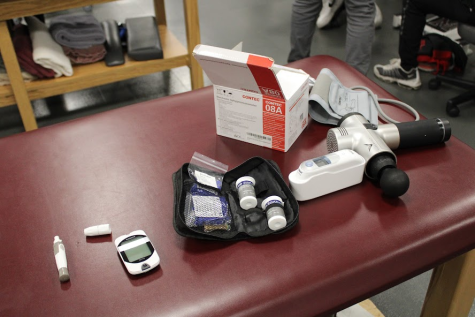
From concussions to sprains and general medical conditions, there’s an AT for that. As a critical component in the health care profession, athletic trainers are equipped to prevent, diagnose and treat a variety of health issues. Often providing the necessary preemptive, emergency and life-saving care for all athletes.
Celebrate athletic trainers throughout National Athletic Training Month and everyday. So the next time you see them roaming the sidelines, observing from a close distance, consider saying thank you and acknowledge them as athletic trainers with some newfound understanding.
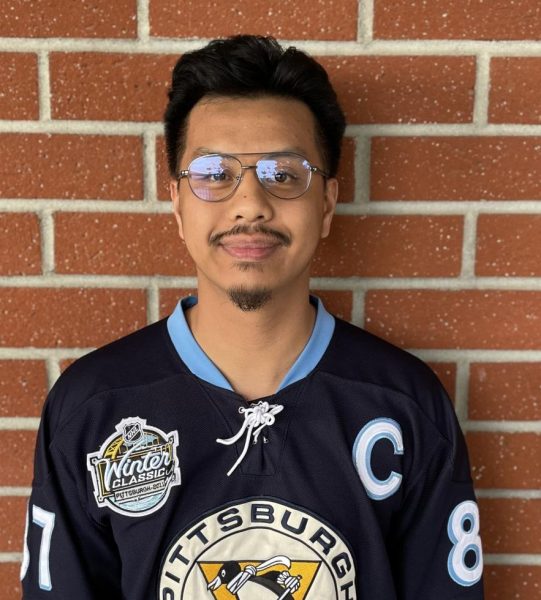
Email: [email protected]


